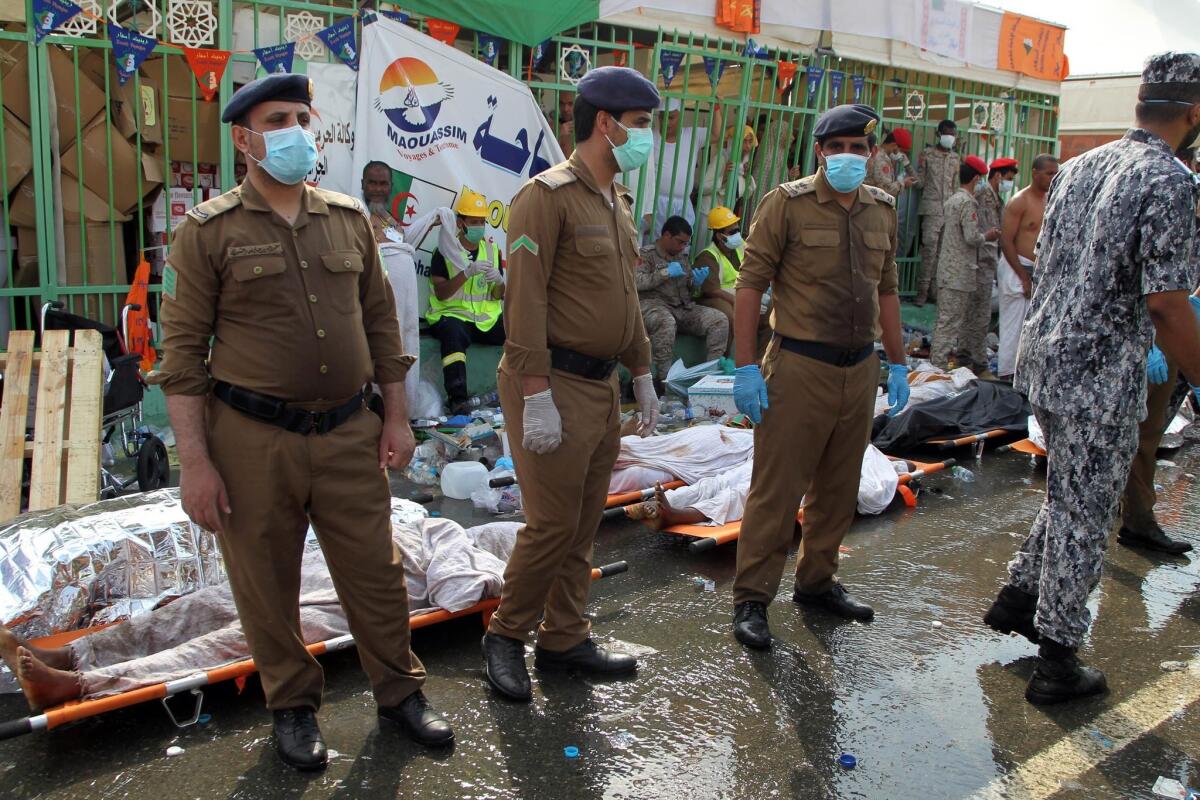Hajj disaster: Are large crowds inherently dangerous?

Saudi emergency personnel stand near bodies of Hajj pilgrims at the site where at least 717 were killed and hundreds injured in a stampede in Mina.
- Share via
As Saudi authorities investigate yet another deadly stampede during the final rite of the hajj pilgrimage Thursday, experts in crowd dynamics say that the root of such tragedies is more often a matter of human flow than it is human fright.
According to Roger Hughes, a professor of civil and environmental engineering at the University of Melbourne, about 2,000 deaths occur each year due to crowding accidents.
Of those deaths, about half are the result of asphyxiation. In other words, crowds have become so dense that people cannot breath.
Although the public and the media often perceive crowds as inherently unpredictable – often prone to violent outbursts or criminal behavior – researchers say this is a myth.
“The conventional way of thinking about crowd psychology is quite simply wrong,” said Stephen Reicher, a professor of social psychology at Scotland’s University of St. Andrews.
“There is talk of ‘stampede’ and of ‘panic’. But stampede suggests that people cause havoc while running away. In disasters like these, the problem is generally that people can’t move at all, let alone run away.” Reicher said.
In fact, a key determinant in the behavior of crowds, according to researchers, is a sense of common fate. Groups in which members share a strong sense of identity are more likely to report instances of people helping one another, according to Reicher and colleague, John Drury, a social psychologist at the University of Sussex in England.
“In short, the problem is primarily crowd physics,” Reicher said. “Crowd psychology can actually make things better, leading people to coordinate better and even help each other in disasters. The only danger is that people who feel part of the crowd may have a false sense of security in overly crowded spaces.”
Such may have been the case Thursday as thousands of Muslim pilgrims gathered at the city of Mina to preform jamarat, the rite of “stoning the devil.” The ritual involves throwing pebbles at three enormous pillars that symbolize Satan.
Authorities say that at least 717 people were killed and more than 800 were injured in the episode.
Instead of a crowd suddenly stampeding like a herd of spooked animals, researchers say trouble begins as people stumble, and those behind keep moving forward because they can’t see what’s happening.
“That is where the crushing arises,” Reicher said.
Researchers say that when a crowd grows to the density of roughly four people per square meter, any contact between people results in waves of pushing. “Waves go backwards and forwards in a potentially critical manner,” Reicher said.
Hughes, who studied the dynamic flow of pilgrims in a fatal crowding episode at jamarat in 1990, said the flawed concept of a violent and irrational crowd entered popular culture during the French Revolution of the 1790s. It was, he said, the result of “sociological writings by aristocrats.”
While studying the 1990 jamarat incident, which resulted in the deaths of 1,426 pilgrims, Hughes used aerial photographs and mathematical models to show that problems arise when pilgrims cluster at the barrier of the first pillar. Not only are people flowing toward the same point, those who have already thrown their stones turn against the flow in order to leave.
“Stoning the first pillar is of uppermost importance,” Hughes wrote of the pilgrims. “They do not consider positioning themselves to stone the second pillar after the first.”
A possible solution Hughes suggested, would be to design a barrier that increased pedestrian flow to the flanks and far side of any pillar.
Follow @montemorin for science news
MORE FROM SCIENCE
9,000-year-old decapitation victim hints at ‘sophisticated’ society
Taking blood pressure drugs at night wards off diabetes, study finds
One in 10 pregnant women admits to drinking, including binge drinking







